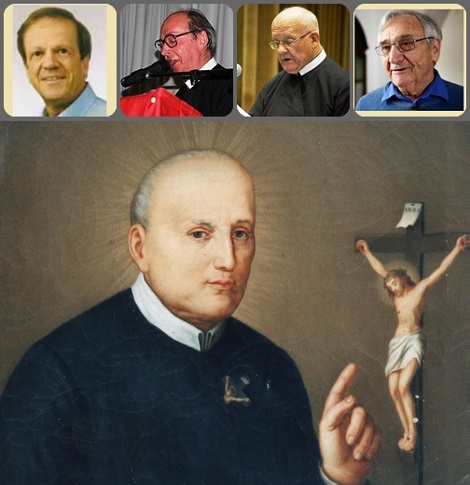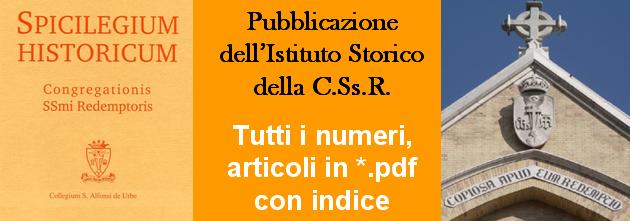Anno 49 (2001) vol. I >>*.pdf intero (1,7 M)
vol. II >>*.pdf intero (1,8 M)
________
[Tutti i files pdf sono OCR]
Studia
- R. Decot, Klemens Maria Hofbauer im politisch-geistigen Umfeld seiner Wiener Zeit. >> pp. I/3-28.
1. Hofbauer in Wien (1808-1820) – 2. Der Diessbach-Kreis: Kirchliche Erneuerung – 3. Der Schlegel-Kreis: Philosophische Grundlegung der Romantik 9 – 4. Der Széchényi-Kreis: Politik und Kirche 12 – 5. Der Hofbauer-Kreis: Katholisch-kirchliche Restauration 13 – 6. Hofbauers Verhalten gegenüber anderen katholischen Erneuerungsansätzen 17 – 7. Hofbauers Bedeutung für die kirchliche Erneuerung in Österreich 24. - M. Brudzisz, Vicende dei Redentoristi-Bennoniti dispersi e tentativi di Clemente Hofbauer di ricostruire la vita comunitaria, 1808-1820. >> pp. I/29-56.
Introduzione 29 – 1. La vita e l’attività pastorale nella diaspora 31 – 2. La sorte del patrimonio immobiliare e degli edifici 41 – 3. I tentativi di far rinascere la vita comunitaria 48.
- H. Schermann, Klemens Maria Hofbauer. Profil eines Heiligen. >> pp. II/281-313.
1. Hofbauer – Seelsorger mit Feingefühl und Leidenschaft; a) – Die Redemptoris-tinnen; b) – Die Oblaten; 2. Hofbauer – aus Überzeugung Redemptorist; a) – Die Bezie-hung Hofbauers zu seinen Ordensobern in Italien; b) – Hofbauers Gründungsversuche; c) – Hofbauers Werben für das Ordensleben; 3) Hofbauer und die Ordensregel; a) – Die sogenannte “Regel von 1782”; b) – Die “Warschauer Regel” von 1789; c) – Die Regel von 1819; 4. Hofbauer und Alfons von Liguori; 5. Hofbauer – kritischer Katholik; 6. Der Mensch Hofbauer; a) – “Ich habe nichts gelernt”; b) – In Europa bewandert; c) – “Ich bin stolz, ich bin eitel”; 7. Hofbauer, der Heilige. – Zum Schluß.
- O. Weiss*, Das Hofbauerbild im Wandel. >> pp. II/315-348.
Einleitung – 1. Klemens Hofbauer, der Leib- und Seelsorger, der Vater der Armen und Ver-lassenen; 2. Klemens Hofbauer, der “Überwinder der Aufklärung und des Josephinismus”; 3. Klemens Hofbauer, der “Vater der Romantik”; 4. Sonstige Hofbauerbilder. – Schluss.
- C. Hoegerl, History of the Cause for Canonization of Blessed Francis Xavier Seelos, CSSR. >> pp. II/351-412.
Contents
I. – Prehistory of the Cause. 1. The Efforts of Brother Louis Kenning, CSSR; 2. Other Ef-forts to Collect Material on the Life and Holiness of Father Seelos; 3. The First Published Biography.
II. – Four processus informativi. 1. The Processus in Pittsburgh, Pennsylvania; 2. The Processus in Baltimore, Maryland; 3. The Processus in New Orleans, Louisiana; 4. The Processus in Augsburg, Germany.
III. – The processus de non-cultu.
IV. -The copiae publicae of the four processes, 1906.
V. – Processus perquisitionis scriptorum, 1908.
VI. – The Summarium of 1908.
VII. – The Informatio of 1910.
VIII. – The long silence.
IX. – The reputation for holiness of father seelos continued during the years of official inactivity.
X. – Progress toward the reactivation of the cause.
XI. – Cheerful ascetic: scientific biography by Michael J. Curley, CSSR
XII. – Further steps toward the reactivation of the cause.
XIII. – Introduction of the cause in the historical section of the Congregation for the causes of saints, april 11, 1970.
XIV. – Positio de virtutibus heroicis; 1. Carl Hoegerl, CSSR, Is Appointed External Col-laborator, 1984; 2. Ambrogio Eszer, O.P., Is Appointed Director (Relatore), His Instruction, 1984-1985; 3. Death of the Redemptorist Postulator General; His Successor, 1986; 4. Report of the Historical Commission in New Orleans, 1994; 5. Decree of the Validity of the Processus, 1994; 6. The New Summarium, 1996; 7. The Documented Biography, 1998; 8. The New Informatio, 1998.
XV. – Decree of heroicity of virtues; 1. Vota of the Historical Consultors; 2. Vota of the Theological Consultors; 3. Vota of the Cardinals and Bishops.
XVI. – Decree on the miracle; 1. Positio super Miraculo; 2. Vota of the Medical Board; 3. Vota of the Theological Consultors, Cardinals, and Bishops.
XVII. – Promulgation of the two decrees, january 27, 2000.
XVIII. – The beatification of Blessed Francis Xavier Seelos, april 9, 2000.
- S. Raponi, I Fratelli laici redentoristi delle origini. Alcuni medaglioni. >> pp. II/413-437.
Introduzione – I. Gioacchino Gaudiello (1719-1741) 414 – II. Vito Curzio (1706-1745) 417 – III. Francesco Antonio Tartaglione (1715-1774) 422 – IV. Antonio Lauro (1723-1763) 426 – V. Antonio Oliva (1730-1775) 429 – VI. Gennaro Rendina (1707-1789) 431 – VII. Pietro Santagata (1736-1794) 433 – VIII. Francesco Antonio Romito (1722-1807) 434.
- A. De Spirito, Una Visitandina del Settecento divulgatrice dell’Istituto alfonsiano in Europa. >> pp. II/439-455.
1. La Visitazione di San Giorgio del Sannio – 2. Una lettera del 1771 – 3. La prima divulgatrice al di là del Regno – 4. Una scelta strategica.
Documenta
- Le “devozioni” nella chiesa di San Bennone e le Costituzioni dei novizi redentoristi a Varsavia, 1787-1808 (manoscritto; a cura di M. Brudzisz). >> pp. I/57-163.
Premessa 57 – 1. La storia del ritrovamento dei testi pubblicati 57 – 2. Identificazione dei testi pubblicati 60 – 3. Le devozioni promosse dai redentoristi a Varsavia 63 – a. Mistero della salvezza 65 – b. Il culto mariano 67 – c. Culto dei santi patroni 69 – 4. Costituzioni e riti 72.- I. HINWEISE AUF DIE HANDSCHRIFT 75 – II. Hinweise auf die Transkription 76 – III. Richtlinien für die Transkription 77 – Devotio oder Andacht 78-162 (varie devozioni e canti, anche in note musicali). - Le Costituzioni dei novizi redentoristi a Varsavia, 1787-1808 (manoscritto; a cura di M. Brudzisz). >> pp. I/165-230.
14 Capitoli – Ritus investiendi 180 – Ritus pro Oblatione 191 – Variae Praeces 196 – Varii Hymni 214 – Index 227.
- G. Orlandi, I Redentoristi a Triberg nei documenti dell’ Archivio di Stato di Modena. >> pp. I/231-264.
Documenti 240
- G. Orlandi, Otto lettere inedite di S. Alfonso. >> pp II/457-474.
Subsidia
- A. Owczarski, Bibliografia hofbaueriana. >> pp. II/475-553.
- Schede bibliografiche >> pp. II/555-579.
- Indice dei Nomi e dei Luoghi I >> pp. I/267-276.
- Libri ricevuti >> pp. 581-582.
- Indice dei Nomi e dei Luoghi II >> pp. II/585-599.
______________

___________________
